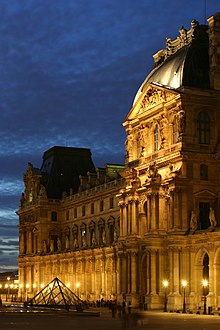An art museum or art gallery is a museum where works of arts are shown for people to look at. These works of art are usually paintings, but they can also be sculptures, photographs or other visual art works. Most art museums are open for the public to visit, but there are also some which are private.

What distinguishes an art museum from other galleries is that it owns the works of art. A museum has staff called "curators", who are expert on art. Art museums are often used to help teach students about the history of art. There are about 700 university art museums and galleries in the United States.[1]
| Name | Country | Opened |
|---|---|---|
| British Museum | United Kingdom | 1759 |
| Centro Cultural Banco do Brasil | Brazil | 1989 |
| Metropolitan Museum of Art | United States of America | 1872 |
| Musée d’Orsay | France | 1986 |
| Museo del Prado | Spain | 1819 |
| Musée National d’Art Moderne | France | 1947 |
| Museum of Modern Art | United States of America | 1929 |
| National Art Center | Japan | 2007 |
| National Gallery | United Kingdom | 1824 |
| National Gallery of Art | United States of America | 1937 |
| Reina Sofia | Spain | 1986 |
| Rijksmuseum | Netherlands | 1800 |
| State Hermitage | Russia | 1764 |
| Shanghai Museum | China | 1952 |
| Tate Modern | United Kingdom | 2000 |
| The Louvre | France | 1793 |
| Van Gogh Museum | Netherlands | 1976 |
| Vatican Museums | Italy | 1506 |
References
change- ↑ Clark, Laine. National Directory. University Art Museums & Galleries in Virginia. [1] Archived 2014-04-18 at the Wayback Machine
- ↑ Discovery, R. S. M. "Ranking The World's Most Admired Art Museums, And What Big Business Can Learn From Them". Forbes. Retrieved 2024-05-08.